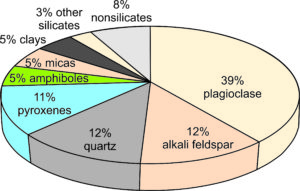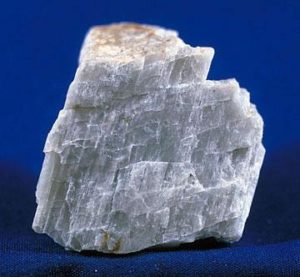2.6.1: Common Elements Make Up the Common Minerals
- Page ID
- 18300
Although more than 90 natural elements exist on Earth, many exist in very small amounts. Occasionally they may be concentrated in accessory minerals, but more often they are just minor diluents for major elements. It is estimated that 14 elements (O, Si, Al, Fe, Ca, Na, K, Mg, Ti, H, P, Mn, Ba, C) make up more than 99.7 wt % of Earth’s crust. We can expect the common minerals to be made from these elements. And, we can expect minerals made of other elements to be rare.
2.23 Common minerals in the crust
Mineralogists have identified more than 5,000 minerals. Of these, fewer than 200 are common, and fewer than 50 are common enough to be considered essential minerals. Abundant oxygen and silicon, together making up nearly three quarters of Earth’s crust, naturally lead to an abundance of silicate minerals. It is no wonder that other types of minerals, or minerals that include rarer elements as key components, are less common. Of the known minerals, about 92% are silicates. Thus, all the nonsilicates together only make up about 8% of the total.
2.24 Plagioclase, a feldspar
The pie diagram above in Figure 2.23 shows estimated abundances of different minerals in the crust. Plagioclase, like the plagioclase shown in this photo (Figure 2.24), is the most abundant mineral (40% of the total) in Earth’s crust because it comprises more than half of the basalt that makes up the oceanic crust. Alkali feldspar and quartz, the major components in granite, make up about another 25%. The other minerals, combined, account for 37% of the total.
●Figure CreditsUncredited graphics/photos came from the authors and other primary contributors to this book. 2.1 Carrollite, Robert M. Lavinsky, Wikimedia Commons |




